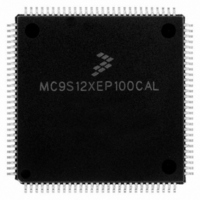MC9S12XEP100CAL Freescale Semiconductor, MC9S12XEP100CAL Datasheet - Page 294

MC9S12XEP100CAL
Manufacturer Part Number
MC9S12XEP100CAL
Description
IC MCU 16BIT 1M FLASH 112-LQFP
Manufacturer
Freescale Semiconductor
Series
HCS12r
Datasheet
1.MC9S12XEP768CAL.pdf
(1328 pages)
Specifications of MC9S12XEP100CAL
Core Processor
HCS12X
Core Size
16-Bit
Speed
50MHz
Connectivity
CAN, EBI/EMI, I²C, IrDA, SCI, SPI
Peripherals
LVD, POR, PWM, WDT
Number Of I /o
91
Program Memory Size
1MB (1M x 8)
Program Memory Type
FLASH
Eeprom Size
4K x 8
Ram Size
64K x 8
Voltage - Supply (vcc/vdd)
1.72 V ~ 5.5 V
Data Converters
A/D 16x12b
Oscillator Type
External
Operating Temperature
-40°C ~ 85°C
Package / Case
112-LQFP
Processor Series
S12XE
Core
HCS12
Data Bus Width
16 bit
Data Ram Size
64 KB
Interface Type
CAN/SCI/SPI
Maximum Clock Frequency
50 MHz
Number Of Programmable I/os
91
Number Of Timers
25
Maximum Operating Temperature
+ 85 C
Mounting Style
SMD/SMT
3rd Party Development Tools
EWHCS12
Development Tools By Supplier
KIT33812ECUEVME, EVB9S12XEP100, DEMO9S12XEP100
Minimum Operating Temperature
- 40 C
On-chip Adc
16-ch x 12-bit
Package
112LQFP
Family Name
HCS12X
Maximum Speed
50 MHz
Operating Supply Voltage
1.8|2.8|5 V
For Use With
EVB9S12XEP100 - BOARD EVAL FOR MC9S12XEP100DEMO9S12XEP100 - BOARD DEMO FOR MC9S12XEP100
Lead Free Status / RoHS Status
Lead free / RoHS Compliant
Available stocks
Company
Part Number
Manufacturer
Quantity
Price
Company:
Part Number:
MC9S12XEP100CAL
Manufacturer:
TOSHIBA
Quantity:
72
Company:
Part Number:
MC9S12XEP100CAL
Manufacturer:
Freescale Semiconductor
Quantity:
10 000
- Current page: 294 of 1328
- Download datasheet (9Mb)
Chapter 7 Background Debug Module (S12XBDMV2)
For hardware data read commands, the external host must wait at least 150 bus clock cycles after sending
the address before attempting to obtain the read data. This is to be certain that valid data is available in the
BDM shift register, ready to be shifted out. For hardware write commands, the external host must wait
150 bus clock cycles after sending the data to be written before attempting to send a new command. This
is to avoid disturbing the BDM shift register before the write has been completed. The 150 bus clock cycle
delay in both cases includes the maximum 128 cycle delay that can be incurred as the BDM waits for a
free cycle before stealing a cycle.
For firmware read commands, the external host should wait at least 48 bus clock cycles after sending the
command opcode and before attempting to obtain the read data. This includes the potential of extra cycles
when the access is external and stretched (+1 to maximum +7 cycles) or to registers of the PRU (port
replacement unit) in emulation modes (if modes available). The 48 cycle wait allows enough time for the
requested data to be made available in the BDM shift register, ready to be shifted out.
For firmware write commands, the external host must wait 36 bus clock cycles after sending the data to be
written before attempting to send a new command. This is to avoid disturbing the BDM shift register
before the write has been completed.
The external host should wait at least for 76 bus clock cycles after a TRACE1 or GO command before
starting any new serial command. This is to allow the CPU to exit gracefully from the standard BDM
firmware lookup table and resume execution of the user code. Disturbing the BDM shift register
prematurely may adversely affect the exit from the standard BDM firmware lookup table.
Figure 7-7
times starting with a falling edge. The bar across the top of the blocks indicates that the BKGD line idles
in the high state. The time for an 8-bit command is 8 × 16 target clock cycles.
1. Target clock cycles are cycles measured using the target MCU’s serial clock rate. See
294
Because of an order from the United States International Trade Commission, BGA-packaged product lines and partnumbers
and
indicated here currently are not available from Freescale for import or sale in the United States prior to September 2010
Section 7.3.2.1, “BDM Status Register (BDMSTS)”
represents the BDM command structure. The command blocks illustrate a series of eight bit
For devices with external bus:
The following cycle count information is only valid when the external wait
function is not used (see wait bit of EBI sub-block). During an external wait
the BDM can not steal a cycle. Hence be careful with the external wait
function if the BDM serial interface is much faster than the bus, because of
the BDM soft-reset after time-out (see
Communication Time
This timing has increased from previous BDM modules due to the new
capability in which the BDM serial interface can potentially run faster than
the bus. On previous BDM modules this extra time could be hidden within
the serial time.
If the bus rate of the target processor is unknown or could be changing or the
external wait function is used, it is recommended that the ACK
(acknowledge function) is used to indicate when an operation is complete.
When using ACK, the delay times are automated.
MC9S12XE-Family Reference Manual , Rev. 1.23
Out”).
for information on how serial clock rate is selected.
NOTE
NOTE
Section 7.4.11, “Serial
Section 7.4.6, “BDM Serial Interface”
1
Freescale Semiconductor
Related parts for MC9S12XEP100CAL
Image
Part Number
Description
Manufacturer
Datasheet
Request
R
Part Number:
Description:
Manufacturer:
Freescale Semiconductor, Inc
Datasheet:
Part Number:
Description:
Manufacturer:
Freescale Semiconductor, Inc
Datasheet:
Part Number:
Description:
Manufacturer:
Freescale Semiconductor, Inc
Datasheet:
Part Number:
Description:
Manufacturer:
Freescale Semiconductor, Inc
Datasheet:
Part Number:
Description:
Manufacturer:
Freescale Semiconductor, Inc
Datasheet:
Part Number:
Description:
Manufacturer:
Freescale Semiconductor, Inc
Datasheet:
Part Number:
Description:
Manufacturer:
Freescale Semiconductor, Inc
Datasheet:
Part Number:
Description:
Manufacturer:
Freescale Semiconductor, Inc
Datasheet:
Part Number:
Description:
Manufacturer:
Freescale Semiconductor, Inc
Datasheet:
Part Number:
Description:
Manufacturer:
Freescale Semiconductor, Inc
Datasheet:
Part Number:
Description:
Manufacturer:
Freescale Semiconductor, Inc
Datasheet:
Part Number:
Description:
Manufacturer:
Freescale Semiconductor, Inc
Datasheet:
Part Number:
Description:
Manufacturer:
Freescale Semiconductor, Inc
Datasheet:
Part Number:
Description:
Manufacturer:
Freescale Semiconductor, Inc
Datasheet:
Part Number:
Description:
Manufacturer:
Freescale Semiconductor, Inc
Datasheet:











